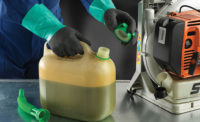General requirements: "Employers shall select and require employees to use appropriate hand protection when employees' hands are exposed to hazards such as those from skin absorption of harmful substances; severe cuts or lacerations; severe abrasions; punctures; chemical burns; thermal burns; and harmful temperature extremes."
Selection: "Employers shall base the selection of the appropriate hand protection on an evaluation of the performance characteristics of the hand protection relative to the task(s) to be performed, conditions present, duration of use, and the hazards and potential hazards identified."
Nuggets of knowledge
OSHA's requirements are just a start. Plenty of tips, guidelines, sample policies, and training programs can be found through an Internet search using the keywords "hand protection." For example, the University of Texas at San Antonio gives employees these guidelines:
- Inspect and test new gloves for defects.
- Always wash your hands before and after using gloves. Wash chemical-protective gloves with soap and water before removing them.
- Do not wear gloves near moving machinery; the gloves may become caught.
- Do not wear gloves with metal parts near electrical equipment.
- Gloves are easily contaminated. Avoid touching surfaces such as telephones and doorknobs when wearing gloves.
Safety glove vendors and distributors are also good sources of information. Here are five suggestions for choosing the right gloves from the industrial supply distributor Cameron & Barkley:
- Determine which category of gloves you will need by assessing the application your employees will execute.
- Determine whether you need a supported glove (with a supporting liner) for additional snag, cut, puncture, or abrasion resistance, or unsupported glove (without a liner) for additional sense and dexterity.
- Based on the activity and immersion of arms, evaluate the necessary cuff design; whether you need a rolled, pinked/serrated, straight, knitwrist, slip-on, safety or gauntlet cuff.
- What length of cuff is needed? Gauntlet lengths vary from 10 to 31 inches depending on the amount of exposure to employees' arms.
- Do you need a pattern design for additional grip? Patterns include pebble, diamond, embossed, and rough.
More details on the sometime tricky job of matching gloves to jobs can be found in an American National Standards Institute (ANSI) voluntary standard. ANSI/ISEA 105-2000, "American National Standard for Hand Protection Selection Criteria," gives you guidance for selecting the correct gloves to protect workers and to assist you in complying with OSHA regulation 29 CFR 1910.138.
Glove performance and pass/fail criteria are included for the following hazardous exposures: cut, puncture and abrasion resistance; protection from cold; chemical permeation and degradation; detection of holes; and heat and flame resistance. The standard also includes reference information on special considerations such as biological protection, electrical protection and radiation hazards.
Users should contact glove manufacturers for information on the glove ratings and labeling of their products that meet this standard. ANSI/ISEA105-2000 is available from ISEA. Discounts for bulk orders are available. To order, call ISEA at (703) 525-1695.
Sample policy
Gloves must be selected for the specific hazard encountered, according to procedures outlined by Radford University's environmental health and safety department, Radford, Va. Gloves should be worn when it's necessary to protect workers from rough, sharp-edged objects, temperature extremes, toxic or corrosive chemicals, and energized electrical sources, according to the policy, which goes on to describe these specifics:Tasks: "Employees should be protected by suitable gloves when engaged in operations hazardous to their hands."
Electrical gloves: "Rubber electrical gloves shall be used to protect workers against electrical shock while working around energized systems. Gloves shall not be used as primary protection when deactivation of the system could be used. Gloves must be visually inspected before use to verify integrity. Each glove must be conspicuously marked with the test date. Rubber protective gloves for electrical workers shall conform to ANSI Standards."
Heat-resistant gloves: "Heat-resistant gloves should be used for handling hot work and working near excessively hot equipment. Gloves should be asbestos-free."
Leather gloves: "Leather gloves are tough and offer good resistance to abrasion and sparks. Leather gloves should be used to protect the hands from rough, sharp objects that may penetrate canvas gloves."
Canvas gloves: "Canvas gloves should be worn to protect workers from wooden splinters, rough edges, and friction burns."
Cut-resistant gloves: "Cut-resistant gloves should be used in areas that regularly require handling sharp objects such as knives or sharp metal."
Welder's gloves: "Specialized gloves should be worn by welders to protect their hands from sparks, heat, and molten metal splashes."
Chemical-resistant gloves: "All employees required to work with chemicals should be provided with chemical-resistant gloves. Chemical-resistant gloves must be selected based on the chemical being handled. Gloves are not impermeable to all chemicals. In general, neoprene gloves protect against acids, bases, oils, grease, and solvents; nitrile gloves offer protection from acids, bases, lubricants, and chlorinated solvents; natural rubber resists mild acids, caustics, and detergents; and PVC gloves protect from bases and oils. The manufacturer's catalog or the safety office should be consulted for specific information concerning glove resistance to various chemicals.
Blood: "Workers will wear gloves made of vinyl, latex, or nitrile when it can be reasonably anticipated that hand contact with blood, other potentially infectious body fluids, mucous membranes, or non-intact skin is possible. Rubber household utility gloves will be used for housekeeping chores that involve handling items or surfaces contaminated with blood or body fluids to which universal precautions apply."
Proper use: "Gloves should be inspected before use for discoloration, punctures, or tears. Gloves should be cleaned or replaced periodically depending on the frequency of use and the permeability of the chemical. When handling highly corrosive and toxic chemicals, two pairs of gloves should be worn. The outer pair may be of a different material to increase the range of protection against a variety of compounds. Gloves should fit comfortably without restricting motion and they should be long enough to protect the wrist, forearm, or the entire arm depending on the application."
Dermatitis: Know it when you see it
Hands and arms are particularly sensitive to skin problems arising from contact with workplace contaminants. OSHA says safety pros need to be able to recognize occupational dermatitis so they can recommend appropriate hand care solutions. Symptoms to look for:
- "Whitened" patches of skin
- Dryness
- Itching pimple- or blister-like lesions
- Slight thickening of the outermost layer of skin
- Small cracks
- Redness
- Swelling
- Numbness and/or tingling.
Industry focus
Certain industries run high risks of hand injuries. According to the Bureau of Labor Statistics, food stores and eating and drinking establishments reported more than 21,000 cut and puncture injuries resulting in lost workdays in 1996. In the same year, nearly 8,000 heat burn injuries resulted in lost workdays in grocery stores and restaurants.In 1999, the BLS recorded these hand injuries: 20,964 cuts and punctures from knives; 6,405 heat burns and scalds; and 6,685 fingertip amputations.
According to OSHA Fact Sheet 93-03, the financial cost of these injuries is more than $300 million per year in lost production time, medical expenses and workers' compensation. To prevent these types of injuries, Volk Enterprises, Inc.'s Safety Today Food Safety Group recommends wearing protective gloves whenever:
- There is any chance that machines or equipment present the hazard of cuts and lacerations.
- There is any chance that cooking operations present the hazard of heat burns, scalds or a combination of hazards.
- Foodservice operations present the hazard of dermatitis or contact with chemicals, bloodborne or foodborne pathogens.
Cost of injuries
Road constructors pay out $48 million more for hand injuries each year than it would cost them to equip all of their hazard-exposed workers with protective gloves. That's the bottom line for road construction companies, according to figures compiled from the BLS, National Safety Council (NSC), American Road and Transportation Builders Association (ARTBA) and International Safety Equipment Association (ISEA).How so? Start with 574,000 hazard-exposed road construction workers in the private sector (ARTBA). Apply a 64 percent usage rate for protective gloves when needed among road construction workers (ISEA 2001 survey), meaning that 36 percent (206,640 workers) are not using protective gloves when they need them. Multiply that number of workers by the cost each year to equip each of those workers with ten pairs of gloves at $4 a pair ($40), yielding a total cost of $8.3 million to equip with gloves all remaining road construction workers.
Now multiply the total number of annual lost-time hand injuries in road construction, which is about 2,020 (based on conservative extrapolation from BLS data) by the $28,000 cost per on-the-job injury (NSC), yielding a total cost for hand injuries in road construction of $56.6 million. Subtract the $8.3 million cost of equipping all unprotected workers from that figure to derive the $48.3 million more that road construction companies pay out each year for hand injuries.
"Wearing abrasion- and laceration-resistant gloves will not protect against every potential hand injury, and we are not saying that it would," says ISEA President Dan Shipp. "But this data does suggest that road construction companies are spending a whole lot more to cover the costs of hand injuries each year than they would pay to equip their workers properly and make sure they are wearing their gloves when they need them."
For details on the statistical basis of this cost-benefit profile, contact ISEA's Joe Walker, (703) 525-1695.

